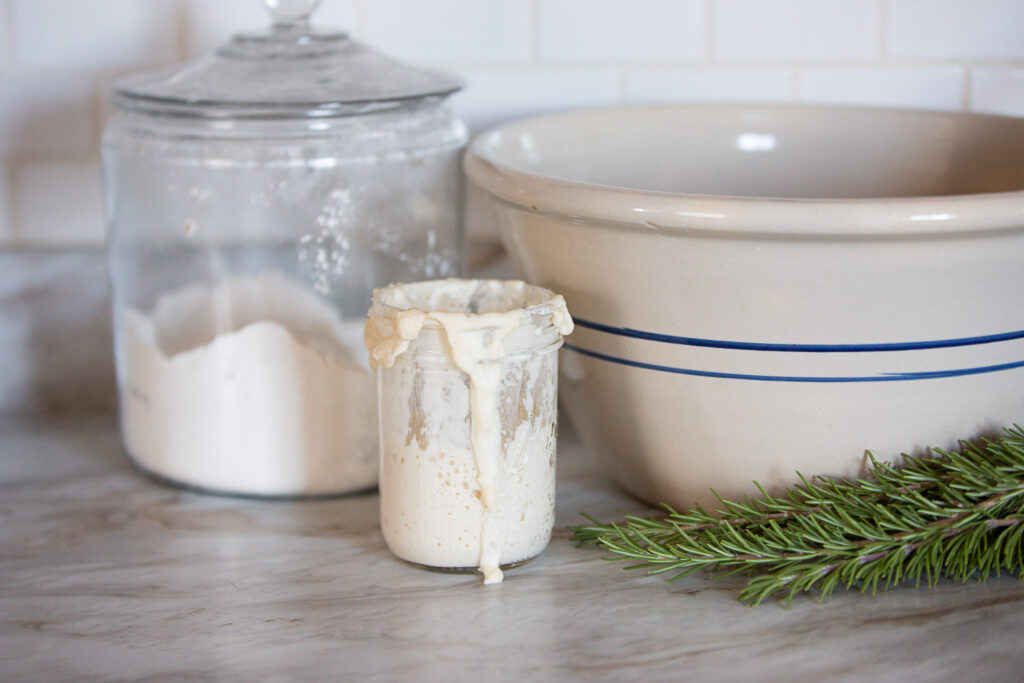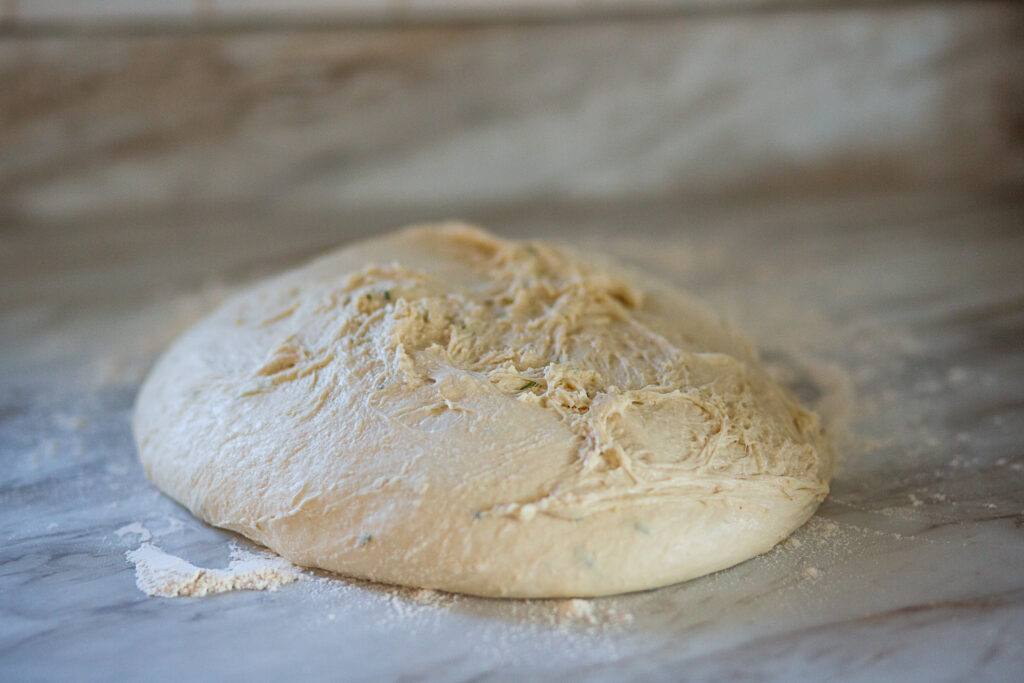This rosemary sourdough bread is chewy and savory with a subtle taste of rosemary. You need this freshly baked bread in your kitchen!

This post contains affiliate links which means I make a small commission at no extra cost to you. See my full disclosure here.
Making a fresh loaf of bread is a part of our daily routine that brings so much joy in out household. Most days we do a standard sourdough loaf or a whole wheat sandwich bread. On days that I am feeling like playing around in the kitchen, I will throw special ingredients into the dough for something different! I love do do roasted garlic, jalapeño cheddar, or pesto! Most often we use fresh herbs from out garden.

Rosemary does well in our climate, so naturally we use it a lot! I like to make this rosemary parmesan bread around Christmas for gifts since it makes four loaves at a time. Rosemary with sourdough is one of my favorite combinations! It makes a regular sourdough bread feel so special!

Tools you’ll need to make rosemary sourdough bread
- Large Ceramic or Glass Mixing Bowl
- Bread Banneton Proofing Basket
- Tea Towels
- Dutch Oven
- Parchment Paper
- Danish Dough Whisk
- Bread Scoring Knife
Ingredients you’ll need to make rosemary sourdough bread
- 1 1/4-1 3/4 cups water
- 1/2 cup fed sourdough starter
- 1 tsp salt
- 3-4 cups flour
- 2 Tbsp fresh rosemary, minced
- Rice flour, for dusting the proofing basket

How to make rosemary sourdough bread
Mixing the dough
- Measure flour, water, FED sourdough starter, and salt in a large mixing bowl. Start with the lowest amount of flour and water.
- With a dough whisk, mix all of the first four ingredients until everything is combined. Mixing everything well in this step is extremely important! The dough will be lumpy and bumpy, but as long as the ingredients are well mixed that will smooth out later.
- If you need to add more flour and water for the dough to achieve a consistency between pancake batter and play dough do that now.
- Gently fold in the rosemary until they are evenly distributed throughout the dough.
- With a damp tea towel, cover the bowl and let sit for 30 minutes.

Stretch and fold the dough
- After 30 minutes, uncover the bowl and do a stretch and fold. (see section for how to stretch and fold). Repeat this process 3 times.
- Cover the bowl back up and let rest for 30 more minutes.
Bench Rest
- After 30 minutes, release the dough onto a clean floured counter.
- Gently shape the dough to being careful not to pop all of the small bubbles you created during the stretch and fold process!
- The goal of the shaping process is to get the dough smooth and tight on the top of the dough, and form your desired loaf shape. Tuck all loose ends underneath the loaf.
- Cover the dough with a damp tea towel and let sit on the counter for 30 minutes. This is your bench rest!
Proof the dough overnight

- Dust rice flour on the proofing basket and be generous! It is important to get enough rice flour on the basket, so your dough doesn’t stick in the crevices of the basket.
- Place the dough top side down into the proofing basket.
- Cover and let dough proof overnight.
Bake rosemary sourdough bread
- The next day, preheat dutch oven in a 500F degree oven for 30 minutes.
- Turn dough out of proofing basket onto a piece of parchment paper on the counter.
- Score the dough with a sharp scoring knife.
- Lift the dough into the hot dutch oven, and cover.
- Bake for 30 minutes.
- Uncover for the last 5-10 minutes to get a nice brown crust.
- Remove loaf from the oven and set onto a cooling rack.
- Let the loaf cool completely before slicing with a sharp serrated knife.
A note on how much flour and water to use
You will notice that this recipe allows for a window of flour and water to be used. That is because every kitchen is different. Even within my own kitchen, I can use a slightly difference flour to water ratio depending on the weather, temperature of my home, and humidity. Bread baking is something that takes a little trial and error to understand fully how to bake for your kitchen.
The goal or when the dough is mixed is that it is just able to form one mass of dough while pulling away from the bowl. It might seem a little wet and lumpy at this stage. Keep in mind that the stretching and folding will smooth the lumps. The dough will also have a bit of flour added during the bench rest process, and the flour will absorb the moisture stiffening the dough.

HOW TO STRETCH AND FOLD
Stretching and folding during the bulk fermentation is extremely important! Stretching and folding your dough:
- Strengthens the dough
- Helps equalize dough temperature
- Allows for the baker to monitor the strength of the dough
- Traps little air pockets in the dough…you’ll see them when you shape the loaf!
If you are unsure how to properly do this, learn how to stretch and fold before beginning this recipe. It is really simple once you get the hang of it!
Rosemary sourdough bread tips
- Use slightly wet hands when working with your dough. This will prevent the dough from sticking to your hands.
- Start in the morning. Though this recipe has very little actual work time, it does need hours to ferment, so starting in the morning will ensure you get your loaf into the refrigerator to proof overnight before bedtime.
- Use an extremely sharp scoring knife! This will prevent dragging the knife, which may result in a flatter loaf.
- Make sure your oven is hot! Avoid putting the loaf into a cold oven. I preheat my cast iron dutch oven in the oven before putting the loaf into it.

Commonly asked questions
When to add rosemary to sourdough?
Rosemary should be folded into the sourdough dough before it is baked, after the rest of the ingredients are added. There should be rosemary in the bread before the stretch and fold process.
How to make rosemary sourdough bread in dutch oven?
It is important to preheat your dutch oven before adding the sourdough into it. Lower the scored sourdough loaf with parchment paper beneath it, into the dutch oven. Bake with the lid on for about 25-30 minutes. Remove the lid and bake for 10 minutes more to get a nice brown crust.
You may also be interested in:
Sourdough Pumpkin Cinnamon Rolls
Rosemary Sourdough Bread

This rosemary sourdough bread is chewy and savory with a subtle taste of rosemary. You need this freshly baked bread in your kitchen!
Ingredients
- 1 1/4-1 3/4 cups water
- 1/2 cup fed sourdough starter
- 1 tsp salt
- 3-4 cups flour
- 2 Tbsp fresh rosemary, minced
- Rice flour, for dusting the proofing basket
Instructions
- Measure flour, water, FED sourdough starter, and salt in a large mixing bowl. Start with the lowest amount of flour and water.
- With a dough whisk, mix all of the first four ingredients until everything is combined. Mixing everything well in this step is extremely important! The dough will be lumpy and bumpy, but as long as the ingredients are well mixed that will smooth out later.
- If you need to add more flour and water for the dough to achieve a consistency between pancake batter and play dough do that now.
Gently fold in the rosemary until they are evenly distributed throughout the dough. - With a damp tea towel, cover the bowl and let sit for 30 minutes.
- After 30 minutes, uncover the bowl and do a stretch and fold. (see section for how to stretch and fold).
- Repeat this process 3 times.
Cover the bowl back up and let rest for 30 more minutes. - After 30 minutes, release the dough onto a clean floured counter.
Gently shape the dough to being careful not to pop all of the small bubbles you created during the stretch and fold process! - The goal of the shaping process is to get the dough smooth and tight on the top of the dough, and form your desired loaf shape. Tuck all loose ends underneath the loaf.
- Cover the dough with a damp tea towel and let sit on the counter for 30 minutes. This is your bench rest!
- Dust rice flour on the proofing basket and be generous! It is important to get enough rice flour on the basket, so your dough doesn’t stick in the crevices of the basket.
- Place the dough top side down into the proofing basket.
Cover and let dough proof overnight. - The next day, preheat dutch oven in a 500F degree oven for 30 minutes.
Turn dough out of proofing basket onto a piece of parchment paper on the counter. - Score the dough with a sharp scoring knife.
Lift the dough into the hot dutch oven, and cover. - Bake for 30 minutes.
- Uncover for the last 5-10 minutes to get a nice brown crust.
Remove loaf from the oven and set onto a cooling rack. - Let the loaf cool completely before slicing with a sharp serrated knife.
Pin it for later!


Leave a Reply